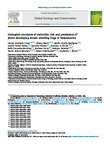Ecological correlates of extinction risk and persistence of direct-developing stream-dwelling frogs in Mesoamerica
| dc.contributor.author | Zumbado-Ulate, H | |
| dc.contributor.author | Neam, K | |
| dc.contributor.author | García-Rodríguez, A | |
| dc.contributor.author | Ochoa-Ochoa, L | |
| dc.contributor.author | Chaves, G | |
| dc.contributor.author | Kolby, JE | |
| dc.contributor.author | Granados-Martínez, S | |
| dc.contributor.author | Hertz, A | |
| dc.contributor.author | Bolaños, F | |
| dc.contributor.author | Ariano-Sánchez, D | |
| dc.contributor.author | Puschendorf, Robert | |
| dc.contributor.author | Searle, CL | |
| dc.date.accessioned | 2022-07-01T14:32:30Z | |
| dc.date.available | 2022-07-01T14:32:30Z | |
| dc.date.issued | 2022-10 | |
| dc.identifier.issn | 2351-9894 | |
| dc.identifier.issn | 2351-9894 | |
| dc.identifier.other | e02197 | |
| dc.identifier.uri | http://hdl.handle.net/10026.1/19377 | |
| dc.description.abstract |
Understanding the threats to wildlife across space and time is essential for developing effective conservation strategies. In Mesoamerica (i.e., the region that extends from Central Mexico to the most southern point in Panama) at least 40% of amphibian species declined between the late 1970s and the early 2000s. Most of these declines have been linked with the destruction of suitable habitats for amphibians as well as the introduction and spread of the fungal pathogen Batrachochytrium dendrobatidis, the causal agent of the disease known as chytridiomycosis. In this study, we quantified geographic and elevational ranges for direct-developing, stream-dwelling frog species (DSFS) in Mesoamerica. Within the range of each DSFS, we estimated the extent of suitable area for the occurrence of Batrachochytrium dendrobatidis and the types of land use to quantify habitat deterioration. To date, 33% of DSFS remain undetected since 2005 or before. At the regional level (i.e., Mesoamerica), as in previous studies, we found that narrow geographic and elevational ranges increased vulnerability to extinction. Nevertheless, the ranges of 83% of DSFS were composed of 50% or more high-quality habitats between the 1980s and 2005, when most species declined. We also found that on average, 80% of the range of each species currently overlaps with predicted suitable areas for the occurrence of Batrachochytrium dendrobatidis. At the local and site level (i.e., focusing on two species ranges where extensive monitoring has been conducted even before decline occurred), we found that the present suitable habitat for Batrachochytrium dendrobatidis corresponded with the reduction in predicted habitat suitability and climatic niche of DSFS. We also found that the location of remnant populations can be predicted by environmental factors, which can help identify regions where remnant populations of these declined species and others with similar ecology may occur. Combined, results from our regional and local analyses support the idea that Batrachochytrium dendrobatidis was the main driver of DSFS declines and of the current lack of recent observations of fifteen DSFS. We used our results to propose specific actions for all DSFS included in this study. This study highlights the importance of considering multiple threats and spatial scales when assessing the status of declined and threatened species. | |
| dc.format.extent | e02197-e02197 | |
| dc.language | en | |
| dc.language.iso | en | |
| dc.publisher | Elsevier | |
| dc.subject | Amphibian declines | |
| dc.subject | Batrachochytrium dendrobatidis | |
| dc.subject | Disease | |
| dc.subject | Habitat deterioration | |
| dc.subject | Habitat suitability maps | |
| dc.subject | Range | |
| dc.title | Ecological correlates of extinction risk and persistence of direct-developing stream-dwelling frogs in Mesoamerica | |
| dc.type | journal-article | |
| dc.type | Journal Article | |
| plymouth.author-url | https://www.webofscience.com/api/gateway?GWVersion=2&SrcApp=PARTNER_APP&SrcAuth=LinksAMR&KeyUT=WOS:000836456400004&DestLinkType=FullRecord&DestApp=ALL_WOS&UsrCustomerID=11bb513d99f797142bcfeffcc58ea008 | |
| plymouth.volume | 38 | |
| plymouth.publication-status | Published | |
| plymouth.journal | Global Ecology and Conservation | |
| dc.identifier.doi | 10.1016/j.gecco.2022.e02197 | |
| plymouth.organisational-group | /Plymouth | |
| plymouth.organisational-group | /Plymouth/Faculty of Science and Engineering | |
| plymouth.organisational-group | /Plymouth/Faculty of Science and Engineering/School of Biological and Marine Sciences | |
| plymouth.organisational-group | /Plymouth/REF 2021 Researchers by UoA | |
| plymouth.organisational-group | /Plymouth/REF 2021 Researchers by UoA/UoA06 Agriculture, Veterinary and Food Science | |
| plymouth.organisational-group | /Plymouth/Users by role | |
| plymouth.organisational-group | /Plymouth/Users by role/Academics | |
| dcterms.dateAccepted | 2022-06-15 | |
| dc.rights.embargodate | 2022-7-2 | |
| dc.identifier.eissn | 2351-9894 | |
| dc.rights.embargoperiod | Not known | |
| rioxxterms.versionofrecord | 10.1016/j.gecco.2022.e02197 | |
| rioxxterms.licenseref.uri | http://www.rioxx.net/licenses/all-rights-reserved | |
| rioxxterms.type | Journal Article/Review |


